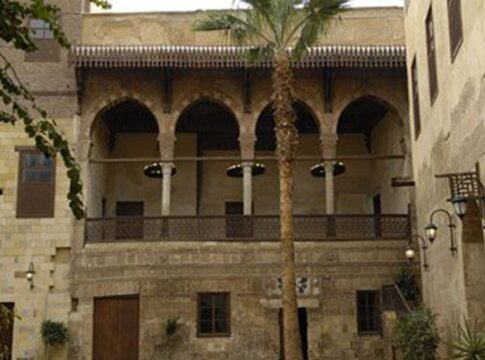I was delighted to spend Saturday with Mohamed Abaza, the founder and owner of “El Mosafer Khan.” His extensive knowledge and passion for historical sites made our journey through old Egypt both enriching and entertaining. Our tour began at Dar Taz, followed by visits to AlTekia Al-Mawlawiyah, the newly renovated Sayeda Zeinab Mosque, and concluded at the Ahmed ibn Tulun Mosque. Today, I invite you to join me as we explore our first stop.
Nestled in the historic heart of Cairo, the Amir Taz Palace stands as a majestic testament to the city’s rich history and architectural splendor. This iconic Mamluk palace, also known as Dar Taz, has witnessed centuries of cultural evolution, political intrigue, and artistic renaissance. Let’s embark on an enchanting journey to explore the captivating tales and timeless beauty of this grand edifice.
The Story of Amir Taz: A Tale of Ambition and Tragedy
The story of Amir Taz mirrors the ambitions, rivalries, adventures, and tragedies that define Mamluk history. The Mamluks ruled Egypt from 1250 to 1517 AD, and Taz’s journey is a vivid tapestry of that era’s tumultuous events.
Amir Taz began his career as the cup-bearer (saqi) to Sultan al-Nasir Mohamed ibn Qalawun, one of Egypt’s greatest rulers. Rising through the ranks, he married the sultan’s daughter, Khwand Zahra, and became the grand dawader, or executive secretary of the chancery.
After Sultan al-Nasir’s death in 1340, a power struggle ensued among the Mamluk princes. In 1347, a young boy named Hasan, with red hair and freckles, was placed on the throne. However, when Hasan began dismissing high officials, Taz feared for his own position and deposed Hasan, installing his younger brother as sultan.
But the political landscape was rife with rivalries. Amir Shaykhu, a powerful supporter of Hasan, bided his time. Three years later, while Taz was away hunting, Shaykhu seized the opportunity, sent the boy sultan to the harem, and reinstated Hasan. Taz returned to Cairo with his Mamluks, ready to fight. Finding himself outnumbered, he dispersed his troops and sought refuge in his sister’s house. Eventually, he walked unarmed to the Citadel and presented himself to Sultan Hasan.
The reconciliation was emotionally charged, but the sultan exiled Taz to Aleppo in northern Syria. There, Taz built a formidable army, causing alarm in Cairo. Summoned back to the capital, Taz was imprisoned in Alexandria by his rivals, Shaykhu and Sargatmish, and was blinded to remove him from the political scene forever.
Despite his tragic fall, Taz outlived his enemies. Shaykhu and Sargatmish met their ends through assassination or execution. Sultan Hasan eventually freed Taz, allowing him to spend his remaining days in Mecca, where he died in 1361 AD.
A Palace Born of Love and Ambition
The palace was constructed in 1352 by the illustrious Mamluk Prince Taz al-Nasiri to celebrate his marriage to Sultan al-Nasir Mohammad’s daughter. Spanning an impressive 8,000 square meters, the palace’s strategic location near the citadel underscores its historical significance as a center of power. Its most striking feature is the maq’ad, a grand seat that overlooks a vast inner courtyard adorned with beautifully decorated halls.
A Tapestry of Architectural Brilliance
The Amir Taz Palace is a sublime example of Bahari Mamluk architecture, blending Islamic, Ottoman, and regional influences. The ceilings are adorned with intricate geometric and plant motifs, while the walls boast bands that record the titles of Prince Taz. The octagonal hall, with its high stucco-worked ceiling, serves as the palace’s centerpiece, capturing the essence of Islamic architectural precision.
Visitors are greeted by the main entrance on Al-Suyufiya Street, a portal rich with stalactite forms and secondary arches. The western entrance, used for carriages, leads directly to the central courtyard, while the eastern entrance offers a more simplistic style, reflecting the palace’s blend of grandeur and modesty.
A Cultural Revival
After centuries of transformations and neglect, the palace has undergone significant restorations, transforming it into a vibrant cultural hub. Today, the palace hosts concerts, exhibitions, and art workshops, seamlessly fusing ancient history with contemporary creativity. The Cultural Development Fund has revitalized the palace, making it a beacon of artistic expression and cultural heritage.
Exploring the Palace
Upon entering, visitors traverse a rectangular passage leading to the main reception building and the cellar. The palace’s intricate design includes beautifully decorated halls with wooden windows, a large garden, and a parlor supported by marble columns. The ceilings, adorned with Persian script, and the walls, inscribed with the titles of Prince Taz, offer a glimpse into the artistic prowess of the Mamluk era.
As sunlight filters through stained glass windows, the interiors come alive with a kaleidoscope of colors, creating a mesmerizing visual spectacle. The palace’s symbolic patterns and motifs, rooted in religious significance, invite visitors to unravel the narratives embedded in its very fabric.
A Beacon of Heritage
The Amir Taz Palace is not merely a historical monument but a living testament to Cairo’s enduring legacy. It offers a unique glimpse into the architectural, cultural, and social dynamics of the Mamluk period. As a venue for cultural activities and artistic events, the palace continues to celebrate its rich heritage, ensuring that the legacy of Prince Taz lives on for generations to come.
Visit Amir Taz Palace
Located at 27 Suyufiya Street, Khalifa, the Amir Taz Palace is a must-visit for history enthusiasts and cultural explorers. From the bustling streets of Old Cairo, the palace beckons with its timeless charm and majestic presence. Whether you are captivated by its architectural brilliance or intrigued by its historical narratives, the Amir Taz Palace promises an unforgettable journey through the annals of time.
In the heart of Cairo, the Amir Taz Palace stands as a beacon of history, art, and culture. Its walls whisper tales of a bygone era, inviting you to step into a world where the past and present converge in a harmonious dance of heritage and innovation. Come, be a part of this enchanting journey and discover the timeless majesty of the Amir Taz Palace.



